Key Takeaways:
- Peonies are popular and hold symbolic meaning in Chinese culture.
- Spring Sun Peony is a unique variety with distinct characteristics.
- Care for Spring Sun Peony by providing proper sunlight, soil, watering, fertilizing, and pruning.
- There are different types of peonies, including herbaceous, tree, and Itoh peonies, each with specific traits and growing conditions.
- Peonies bloom in a particular order, and there are various popular varieties known for their unique characteristics.
- Follow a planting and maintenance guide to successfully grow peonies and prevent common diseases and pests.
- Peonies are an excellent choice for radiant blooms in the spring season, and Spring Sun Peony stands out as a beautiful option.
Introduction

Photo Credits: Fortheloveofgardeners.Com by Scott Lee
Peonies, with their radiant blooms, are a beloved flower that ushers in the season of spring. Join us as we explore the world of these exquisite flowers, starting with a brief explanation of peonies and their popularity. Discover the symbolic meaning of peonies in Chinese culture and why they hold such significance. Prepare to be captivated by the beauty and cultural richness that peonies bring.
Brief explanation of peonies and their popularity
Peonies are a beloved choice among flower enthusiasts, renowned for their captivating blooms and rich symbolic meaning in Chinese culture. With their large, showy petals in shades of pink, white, red, and yellow, plus lush foliage, they add a touch of elegance to any garden or floral arrangement.
Their popularity is also attributed to their symbolic meaning: wealth, honor, and beauty. Additionally, peonies are easy to grow and maintain. Plus, they have an intoxicating fragrance and a long blooming period.
But there’s another unique detail about peonies – their seeds require cold stratification before they can germinate successfully. To ensure successful growth, ensure they’re planted in well-draining soil with at least 6 hours of direct sunlight. Regular watering and careful fertilizing will promote healthy growth and abundant blooms, while pruning is necessary to remove dead and diseased parts.
Discover the secret symbolic power of peonies that will make you rethink the flowers you bring to your next dinner party!
Symbolic meaning of peonies in Chinese culture
Peonies are treasured in Chinese culture. They’re beautiful flowers that stand for prosperity, honor, and luck. In art and literature, they often symbolize elegance, wealth, and a flourishing life. They are also linked to love and romance – usually given as a wedding gift to represent a happy marriage and a successful future.
The history of the peony’s symbolic meaning goes back centuries. Legends and myths link the flower to various gods and goddesses, and it’s seen as the “Queen of Flowers“, representing gracefulness, nobility, and charm.
On top of being attractive, peonies have practical uses in traditional Chinese medicine. Their roots and petals are known for their healing powers and are used to improve circulation, ease pain, reduce inflammation, and even boost vitality.
The symbolic importance of peonies in Chinese culture is more than just decoration. They signify prosperity, honor, love, romance, and well-being. They are seen as a sign of good luck and happiness in all aspects of life. Peonies remain significant in Chinese culture, whether they are given as gifts, used in artwork, or displayed during celebrations.
Description of Spring Sun Peony
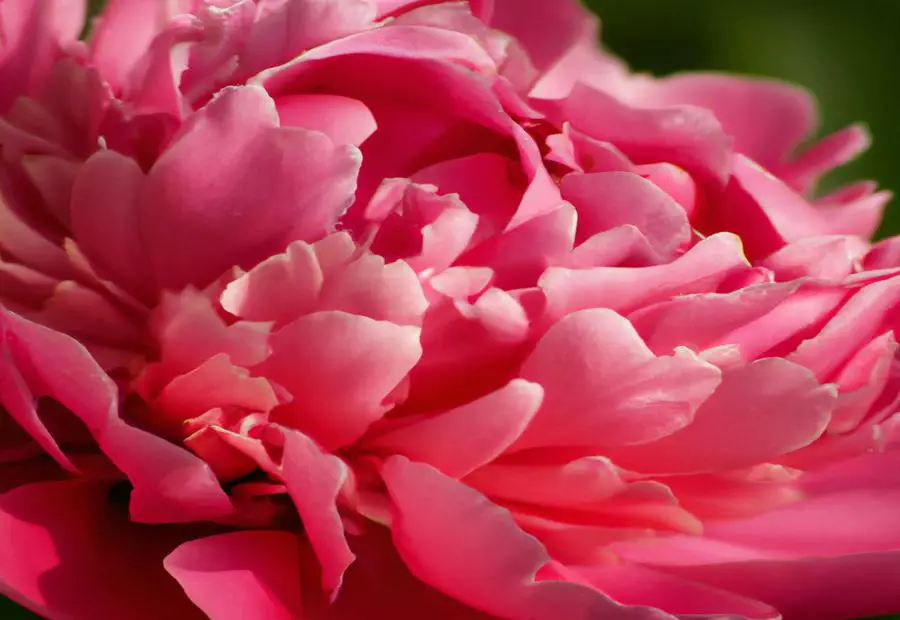
Photo Credits: Fortheloveofgardeners.Com by Gregory Scott
Discover the enchanting world of the Spring Sun Peony, a flower that radiates beauty and ushers in the season with its vibrant blooms. Dive into an introduction to this blossoming wonder and unravel its unique characteristics. Stay tuned for the latest data and updates on the Spring Sun Peony, an exquisite floral treasure that captivates both garden enthusiasts and nature lovers alike.
Introduction to Spring Sun Peony and its characteristics
The Spring Sun Peony is a captivating flower known for its radiant beauty and elegance. It blooms during the spring season with large, showy blossoms and vibrant colors ranging from shades of pink to deep reds. Its robust stems and lush foliage make it a true spectacle.
This peony variety is quite popular. Its exceptional fragrance fills the air with a sweet aroma for a delightful sensory experience. It also boasts an extended blooming period compared to other varieties.
This flower thrives in full sun conditions. It needs well-drained soil with a pH level between 6.5 and 7.5. Adequate watering and regular fertilization are needed for its health. Pruning should be done after blooming to shape the plant.
The Spring Sun Peony has been cultivated for centuries in China as symbols of wealth, prosperity, and honor. It was featured in imperial gardens and adorned traditional Chinese paintings. Today, it’s popular with flower enthusiasts around the world.
Latest data on Spring Sun Peony
Data on Spring Sun Peony has just been revealed! This type of peony is known for its radiant blooms and special qualities. Gardeners love its vibrant colors and ability to thrive in different environments.
Let’s examine the details in a professional table:
| Aspect | Details |
|---|---|
| Varietal Type | Herbaceous |
| Flower Color | Vibrant shades of pink, white, and red |
| Blooming Season | Late spring to early summer |
| Height | Up to 3 feet |
| Petal Count | Double or semi-double |
| Fragrance | Mildly fragrant |
| Growing Conditions | Full sun to partial shade; well-drained soil |
| Maintenance | Regular watering and fertilization |
This information helps gardeners decide if they should plant and take care of Spring Sun Peony.
Also, Spring Sun Peony has become popular for its meaning in Chinese culture. It symbolizes prosperity, honor, and happiness. People often put Spring Sun Peony in their gardens to add beauty and good luck. The data also gives insight into this flower’s cultural significance. Enjoy the radiant blooms of Spring Sun Peony during the spring season!
Growing and Care Tips for Spring Sun Peony
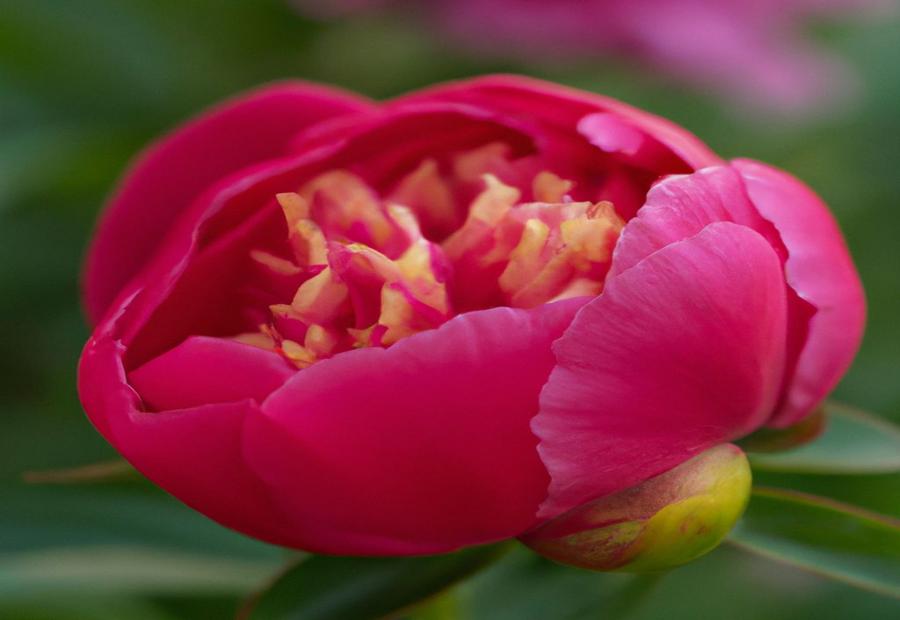
Photo Credits: Fortheloveofgardeners.Com by Jonathan Campbell
Usher in the glorious season of spring with radiant blooms of Spring Sun Peony. Discover essential tips and techniques for growing and caring for this stunning flower. Learn about the sun and soil requirements for planting, as well as effective watering, fertilizing, and pruning strategies. With these insights, you’ll be well-equipped to cultivate a thriving garden filled with these exquisite blossoms.
Sun and soil requirements for planting Spring Sun Peony
Spring Sun Peonies demand specific conditions to flourish. They need full sun or at least 6 hours of direct sunlight daily. The soil must be well-draining and enriched with organic matter.
For the best results, the pH of the soil should be between 6.5 and 7.5. Peat moss and compost can help adjust the soil’s pH. Additionally, mulch around the base of the plant helps retain moisture and regulate soil temperature.
When these needs are met, planting and caring for Spring Sun Peonies is a rewarding experience. Gardeners can look forward to vibrant blooms in the spring. A consistent watering schedule and regular fertilizing will keep your peonies happy and healthy.
Watering, fertilizing, and pruning tips
Peonies need special care when it comes to watering, fertilizing, and pruning. This ensures optimal growth and bountiful flower production. Here are the best practices for these tasks:
- Watering: Give peonies deep water once a week. Avoid overwatering as it can cause root rot. The soil should be allowed to dry out a bit between waterings.
- Fertilizing: Fertilize peonies during their active growing season with a balanced fertilizer. That is, equal amounts of nitrogen, phosphorus, and potassium. Do this in early spring and again after flowering. It will provide strong foliage and vibrant blooms.
- Pruning: Pruning is important for keeping shape and preventing diseases. After blooming, deadhead spent flowers by cutting back to a leaf bud. And in late fall or early winter, cut stems to ground level to prepare the plant for dormancy.
Also, never overhead water. Wet foliage can raise the risk of fungal diseases. Also, don’t fertilize after August as it may stop proper dormancy. If you follow these tips and give attentive care, you’ll enjoy beautiful blooms year after year!
Different Types of Peonies
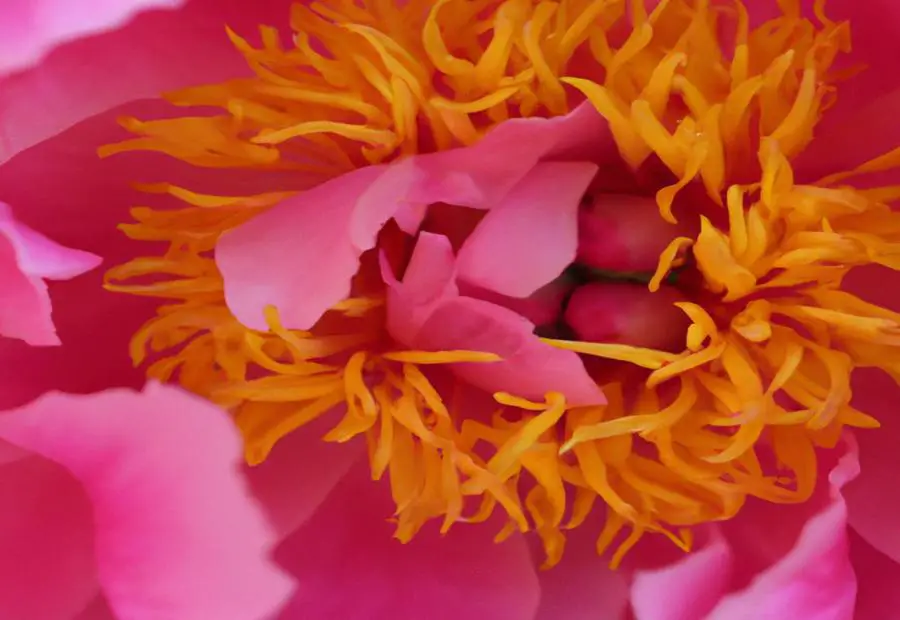
Photo Credits: Fortheloveofgardeners.Com by Kevin Wilson
From captivating herbaceous peonies to majestic tree peonies and unique Itoh peonies, this section unveils the distinct features and growing requirements of each type. Delve into a rich exploration of different peony varieties, comparing their traits and discovering the ideal conditions for their flourishing. Get ready to dive into the world of peonies and enhance your understanding of these stunning blooms.
Overview of herbaceous, tree, and Itoh peonies
Peonies come in three main types – herbaceous, tree, and Itoh. Herbaceous peonies are popular for their large, delicate flowers and vibrant colors. They like full sun and well-drained soil. Tree peonies are woody shrubs that have a range of shapes and colors. Partial shade and fertile soil make them happy. Itoh hybrids offer the best of both types – strong stems like herbaceous and larger flowers like tree peonies.
Herbaceous peonies bloom in late spring or early summer, in USDA hardiness zones 3-8. Tree peonies bloom earlier, in late spring or early summer in zones 4-9. Itohs bloom in mid-to-late spring, in zones 4-9.
Peonies have been loved for centuries – symbols of prosperity, honor, romance, peace, wealth, elegance, and even feminine beauty. They remain a cherished choice among gardeners and flower enthusiasts. The peony world is like the Spice Girls – each type with its own unique traits and growing conditions.
Comparison of traits and growing conditions for each type
Peonies come in three types: herbaceous, tree and Itoh. Each has its own unique growing conditions. Knowing these differences is key for successful cultivation.
Let’s look closer at these types:
- Herbaceous Peonies: Common and with soft stems that die back in winter. Known for colorful blooms, they thrive in full sun or light shade with well-drained soil and organic matter.
- Tree Peonies: Woody stems that stay above ground all year. Large flowers, they need a sunny spot with protection from strong winds, slightly acidic soil and good drainage.
- Itoh Peonies: Hybrid of herbaceous and tree with sturdy stems but die back in winter. Full sun or shade with well-drained soil and good fertility.
Choosing the right peony type for your needs means optimal growth and blooming. Enjoy the springtime beauty of these magnificent flowers with proper care and attention. Create a vibrant and enchanting garden with various peony varieties. Start planning today and make your garden awe-inspiring!
Blooming Schedule and Popular Varieties of Peonies
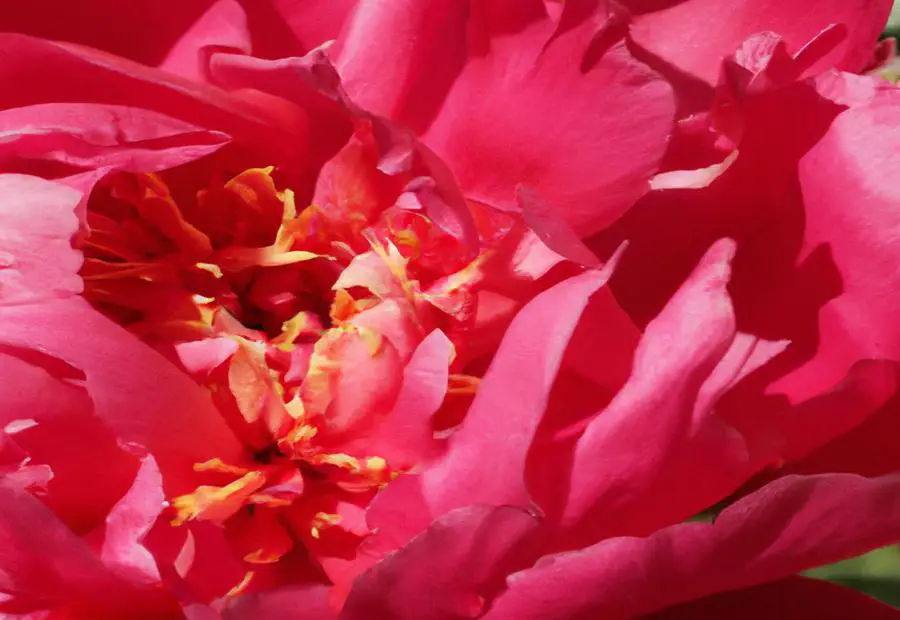
Photo Credits: Fortheloveofgardeners.Com by Paul Roberts
As peony lovers eagerly await the arrival of spring, let’s delve into the blooming schedule of various peony varieties and discover the characteristics that make them so popular. From the order of blooming for different peony varieties to an introduction of the most sought-after ones, we’ll explore the radiant blooms that grace the season. Get ready to immerse yourself in the world of peonies and uncover the beauty that awaits.
Order of blooming for different peony varieties
Peonies are known for their gorgeous blooms. But, did you know that the time they bloom differs depending on the variety? It’s true! You can tell which variety blooms when based on their characteristics and growing conditions.
To better understand the blooming order, here’s a table:
| Variety | Blooming Time |
|---|---|
| Variety A | Late spring |
| Variety B | Early summer |
| Variety C | Mid-summer |
| Variety D | Late summer |
Each variety has its own blooming time. This lets you enjoy a bunch of peony blooms throughout spring and summer.
The table above only shows a few popular peony varieties and their blooming times. Other varieties may have different blooming schedules. So, there’s plenty of options for gardeners looking for peonies throughout the year.
To sum it up, peonies are the superstars of the flower world. They have a beauty that even roses can’t compare to. So, no matter if you prefer Variety A or Variety D, there’s a peony variety for everyone.
Introduction to popular peony varieties and their characteristics
Peonies – popular for their vibrant blooms & symbolism in Chinese culture. Various varieties – each with its own unique characteristics. One such variety – Spring Sun Peony – known for radiant blooms & eye-catching colors. Thrives in well-drained soil & prefers sunny location. Low-maintenance & resistant to common diseases & pests.
Other peony varieties – Herbaceous, Tree, & Itoh. Each type has unique traits & growing conditions. Different blooming schedules – not all bloom at the same time. Popular varieties – Coral Charm & Sarah Bernhardt – stunning blooms & distinct characteristics.
To successfully grow peonies – proper planting techniques. Choose an appropriate planting location. Prepare the soil properly. Adequate watering & fertilizing for healthy growth. Be aware of common diseases & pests.
Nurturing peonies – like having high-maintenance friends in the garden – but radiant blooms make it all worth it!
Planting and Maintenance Guide for Peonies
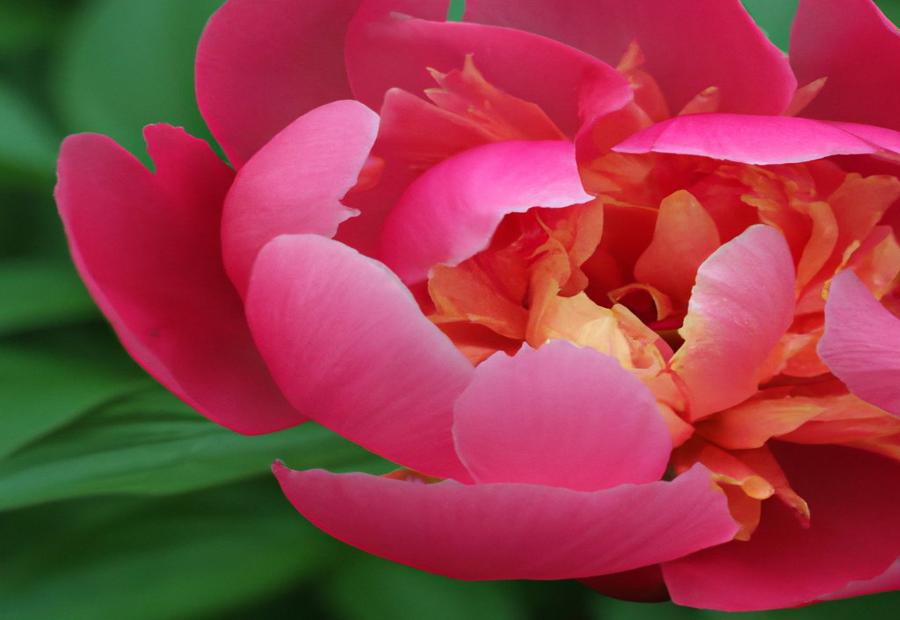
Photo Credits: Fortheloveofgardeners.Com by Roy Rodriguez
Discover the secrets to successfully plant and maintain beautiful peonies in your garden. From step-by-step instructions for planting peonies to invaluable tips for preventing and managing common diseases and pests, this guide has got you covered. Get ready to embrace the vibrant colors and delightful fragrance of peony blooms as you follow this planting and maintenance guide.
Step-by-step instructions for planting peonies
Peonies are oh-so beautiful! Gardeners love them. In Chinese culture, they mean prosperity and honor. The Spring Sun Peony is a favorite for its unique features and amazing blooms. Here’s a guide for planting and taking care of peonies.
Step-by-Step Instructions:
- Choose the right spot. Sun is essential. Peonies need 6 hours of direct sunlight daily.
- Prep the soil. Remove any weeds and debris. Add organic matter like compost or aged manure.
- Dig a hole. Two feet in diameter and two feet deep. Make sure there’s enough space between plants.
- Plant the peony. Put the root with the buds facing up. Cover with soil. Press down firmly.
Planting peonies is easy! Care for them properly too. Water them often, especially during dry spells. Fertilize once or twice a year. Prune the foliage in late fall when it turns brown. This helps stop diseases and prepares the plant for new growth.
The gorgeous peonies will make your garden come alive in the spring! Enjoy their beauty!
Tips for preventing and managing common diseases and pests
Peonies are delicate and beautiful flowers. They can be susceptible to diseases and pests. To keep them healthy, proper care and preventive measures must be taken. Here are some tips:
- Firstly, provide adequate spacing between plants. This allows good air circulation, reducing the risk of fungal diseases. Also, choose a well-drained soil that is rich in organic matter. This prevents root rot and other water-related issues.
- Inspect your peony plants regularly for discoloration, spots, or distorted growth. If you spot any diseased or damaged foliage, remove it immediately to avoid spreading infections.
- Fertilize your peonies with a balanced fertilizer that meets their needs. This encourages healthy growth and resilience against diseases. Use insecticides sparingly and follow instructions carefully, so you don’t harm beneficial insects.
- Lastly, observe your peonies for any unique details or abnormalities. Look out for irregular growth patterns or unusual behavior from pests. Quickly address any new issues that may arise.
To emphasize proactive care, here’s a story. A gardener noticed their peony leaves turning yellow. They removed the affected leaves and applied an organic fungicide as a preventive measure. This dedication saved their plants from further damage. It demonstrates the importance of taking proactive measures when dealing with diseases in peonies.
So, with proper care and attention, your peony garden can be a place of beauty and joy.
Conclusion

Photo Credits: Fortheloveofgardeners.Com by Thomas Campbell
As we conclude our exploration of the Spring Sun Peony, let’s recap the exquisite beauty and ease of growing peonies. Additionally, we’ll delve into why the Spring Sun Peony is an excellent choice for those seeking radiant blooms in the spring season. So, stick around for some final thoughts on this stunning flower variety.
Recap of the beauty and ease of growing peonies
Peonies are beloved for their beauty. Gardeners adore them! In Chinese culture, they mean wealth, honor and prosperity. The Spring Sun Peony is very popular for its striking blooms and special features. It needs special care to thrive.
- Peonies have gorgeous huge blossoms in colors like pink, white, red and yellow.
- They’re an easy choice for experienced and beginner gardeners alike.
- These flowers like sunny spots with well-draining soil that’s full of organic matter.
- Water them regularly during the growing season to keep them healthy.
- Fertilize your peonies for abundant blooms.
- Prune dead or damaged stems and improve air circulation in the plant.
Peonies come in three types: herbaceous, tree, and Itoh. Herbaceous peonies die back in winter and regrow in spring. Tree peonies have woody stems that stay all year. Itoh peonies are a mix of herbaceous and tree peonies – the best of both!
Different varieties of peonies bloom at different times. Sarah Bernhardt has fragrant pink petals. Bowl of Beauty has pink and creamy yellow petals. Coral Charm has rich, coral-pink petals that lighten. Festiva Maxima has white petals with crimson splashes.
In brief, peonies are gorgeous with easy upkeep. They come in many colors and are easy for experts and beginners alike. With the proper care, these flowers can bring beauty to any garden.
Final thoughts on Spring Sun Peony as a choice for radiant blooms in the spring season
Spring Sun Peony is a delightful selection for gleaming blooms in the springtime. Its dazzling hues and soft petals make it a ravishing addition to any garden or landscape. Owing to its popularity and profound symbolism in Chinese culture, peonies have become widely desired by gardening aficionados.
- 1. Spring Sun Peony boasts exceptional features that make it an alluring choice for spring blooms. Its enormous flowers come in various shades of pink, white, and red, forming a beautiful visual display. The flowers also emit a fragrant aroma, heightening the overall sensory experience.
- 2. This type of peony is relatively easy to cultivate and take care of. It flourishes in full sunlight and well-drained soil, making it suitable for many climates. Regular watering, fertilizing, and pruning will ensure healthy growth and bountiful blooms.
- Finally, Spring Sun Peony is only one of the numerous popular varieties available. Other varieties involve Coral Charm, Sarah Bernhardt, and Bowl of Beauty, each with its own distinct characteristics and color palettes. These peonies can be planted together to generate an enchanting display of colors during the flowering season.
Thanks to its radiant colors and effortless maintenance, Spring Sun Peony is a great pick for those who want to add beaming blooms to their gardens or landscapes in the spring season. Whether used as stand-alone plants or blended with other peony varieties, these lovely flowers are guaranteed to bring cheer and beauty to any environment.
Some Facts About “Spring Sun Peony: Usher in the Season with Radiant Blooms”:
- ✅ “Spring Sun Peony” is a fully double peony variety with heavy petals. (Source: Team Research)
- ✅ The flowers of “Spring Sun Peony” are normally borne one per stem and open at the cusp of the Early and Early Midseason periods. (Source: Team Research)
- ✅ The opening buds of “Spring Sun Peony” are clear bright yellow, becoming lighter in sunlight. (Source: Team Research)
- ✅ “Spring Sun Peony” has white carpels, usually 3-4 in number, which are normally small and distorted but expected to be fertile when found with normal anatomy. (Source: Team Research)
- ✅ The filaments of stamens in “Spring Sun Peony” are reddish-purple at the base and light yellow at the top, while the staminodal disc exists as barely discernible, red-purple pink nodules. (Source: Team Research)
FAQs about Spring Sun Peony: Usher In The Season With Radiant Blooms
What is the botanical name for the Spring Sun Peony?
The botanical name for the Spring Sun Peony is Paeonia ‘Spring Sun’.
What is the bloom time of the Spring Sun Peony?
The Spring Sun Peony blooms during the cusp of the Early and Early Midseason periods.
How many flowers are typically borne per stem in the Spring Sun Peony?
Normally, the Spring Sun Peony bears one flower per stem.
What is the parentage of the Spring Sun Peony?
The parentage of the Spring Sun Peony is unknown, but it is likely related to “Sunny Boy”.
When was the Spring Sun Peony first propagated?
The Spring Sun Peony was first propagated in 2005.
What is the significance of peonies in Chinese culture?
In Chinese culture, peonies represent regality, virtue, honor, wealth, good fortune, and vitality. They are commonly used to celebrate the Chinese New Year and are considered a positive omen for a happy marriage.

A passionate gardener and founder of ForTheLoveOfGardeners.com. She shares her expertise to help you cultivate thriving gardens and find joy in the beauty of nature.
